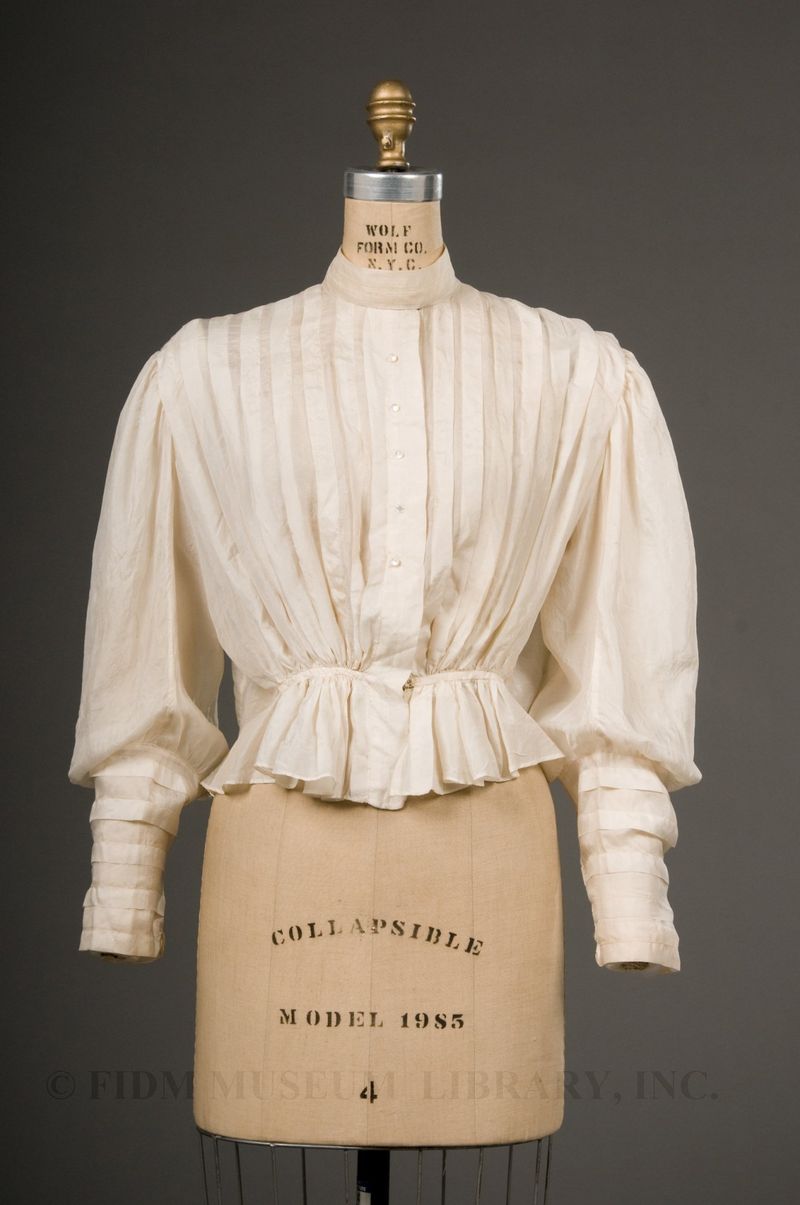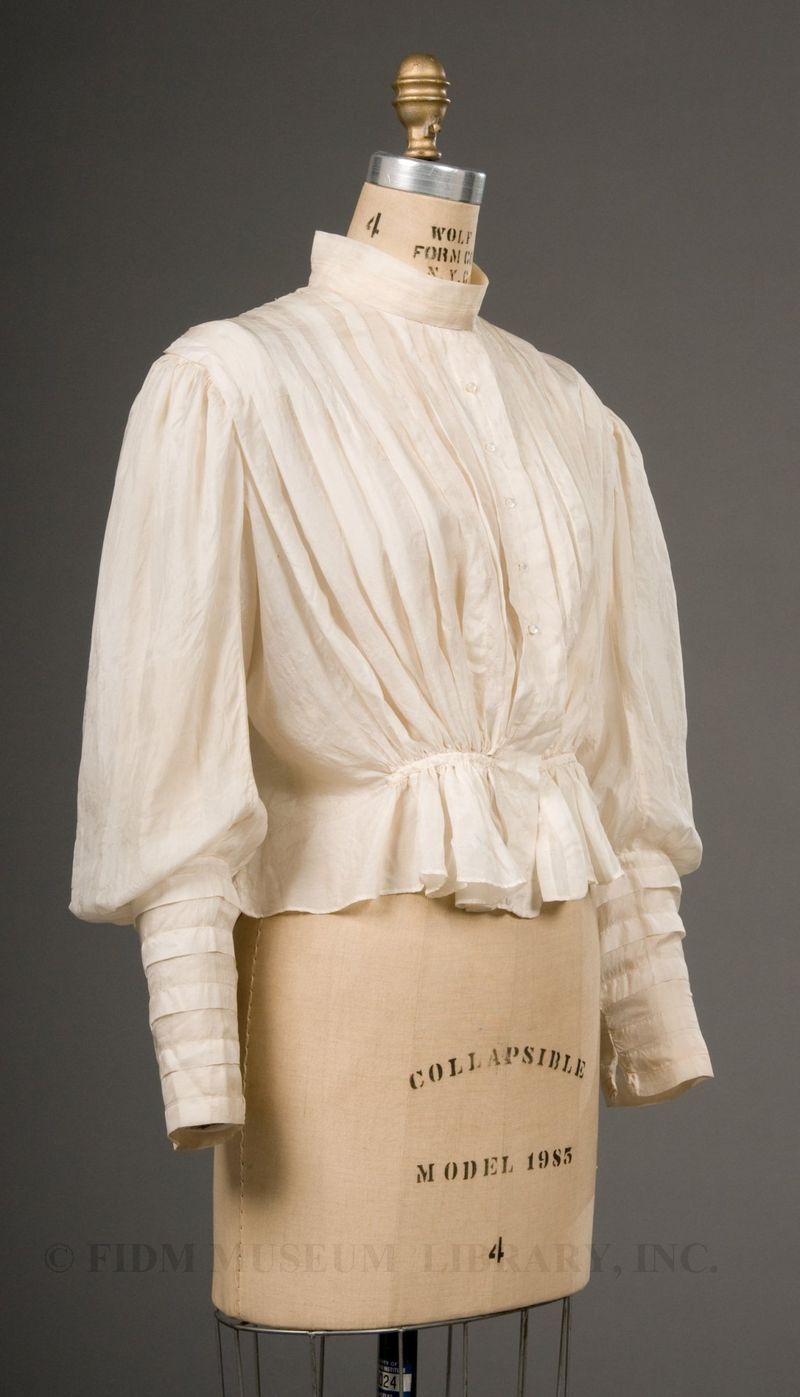1890s shirtwaist
The shirtwaist first emerged in the 1860s as a casual, daytime alternative to the matched bodice and skirt ensembles worn by nearly all well-dress women. Most frequently worn by young women, the shirtwaist was usually paired with a dark colored skirt and accessorized with a belt or sash. The Garibaldi, a high-necked, long sleeved shirtwaist styled to resemble the uniforms worn by the troops of celebrated Italian hero Guiseppe Garibaldi, was the first style of feminine shirtwaist to become widely popular. Though the Garibaldi was occasionally made from red or black wool, it was more commonly fabricated in white cotton. In 1862, Godey's Lady's Book suggested that the new fashion for the Garibaldi shirt worn with a skirt was "destined to produce a change amounting to revolution in ladies' costume."1 Given the rapidly growing popularity of the shirtwaist among women, this would prove to be an accurate prediction.
 Shirtwaist
Shirtwaist
Silk
1890-99
Gift of Ann Jensvold
2003.793.7AB
As a basic garment type, the shirtwaist was endlessly variable. Dainty shirtwaists featured lace insets and delicate embroidery while other versions were tailored in crisp linen or cotton to closely resemble a man's shirt. Most women probably purchased ready-made shirtwaists, as advances in garment sizing and manufacturing meant that quality shirtwaists were available for a reasonable price. The cost of a shirtwaist varied widely, with late 19th century catalogs for stores like Montgomery Ward and Sears, Roebuck, and Co. indicating that shirtwaists could be purchased for almost any price between 25 cents and $7. Because shirtwaists were available in an array of styles at both high and low prices, they were adopted by a tremendous cross-section of American women. Young working women wore white shirtwaists and dark colored skirts for jobs as clerks, sales girls or teachers. Sporting women wore them for participating in activities like bicycling, hunting or mountaineering. Dressy shirtwaists of taffeta or silk were worn for late afternoon receptions or less formal evening occasions.
This shirtwaist from our collection is constructed from a lightweight, almost sheer cream silk. Though a shirtwaist indicated a slightly relaxed mood, it would have been worn with the requisite undergarments: a chemise and corset. The sleeves, full in the shoulder and close-fitting at the lower arm, are typical of the early-to-mid 1890s. During this decade, sleeve fullness and variation were a noted characteristic of women's garments. Because shirtwaists were always tucked neatly into a skirt, the front pleats are gathered into a waist-level band. This clever construction trick would have helped the wearer keep her pleats tidily in place.
The shirtwaist continued to grow in popularity as the 19th century gave way to the 20th century. The Gimbel Brothers Illustrated 1915 Catalog boldly declared that "the women of other lands occasionally wear a shirtwaist--the American woman occasionally wears something else. Her daily apparel is a smart tailored skirt and neat blouse."2 By all accounts, the shirtwaist was ubiquitous, becoming something of a national uniform for American women. For the first time, American women "dressed with a uniformity of look which blurred economic and social distinctions."3 Though the garment itself may have eliminated some outward markers of economic or social difference, the manufacturing process of this widely worn garment highlighted deeply entrenched economic divisions.
In the late 19th century, many ready-made garments, including shirtwaists, were manufactured in small-scale factories known as sweatshops. Crowded, poorly ventilated and staffed with low-paid immigrant labor, sweatshops fed an increased interest in fashionable, affordable, ready-made clothing. Though various activists had already decried the conditions of sweatshop labor, the dire working conditions of many garment workers were highlighted by the Triangle Waist Factory fire of 1911. During this disaster, 146 people (mostly young women) were killed attempting to escape a fire in the premises of a New York City shirtwaist factory. In the aftermath of the fire, new laws and additional enforcement of old laws led to limited improvements in the working conditions of garment workers.
1 "The Garibaldi Shirt" Godey's Lady's Book and Magazine Jan 1862: 21.
2 Gimbel's Illustrated 1915 Fashion Catalog. Reprint, New York: Dover Publications, Inc., 1994: 44.
3 Kidwell, Claudia B., and Margaret C. Christman. Suiting Everyone: The Democratization of Clothing in America. Washington, D.C.: Smithsonian Institution Press, 1974.
